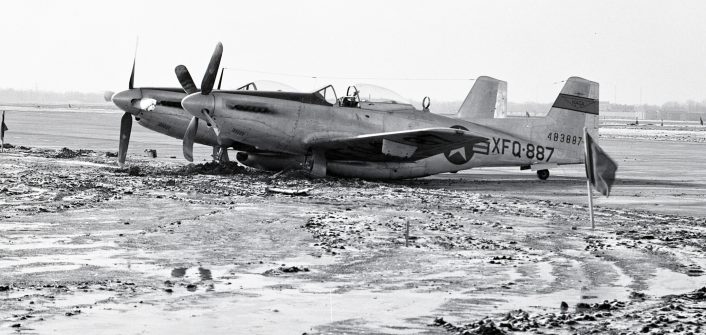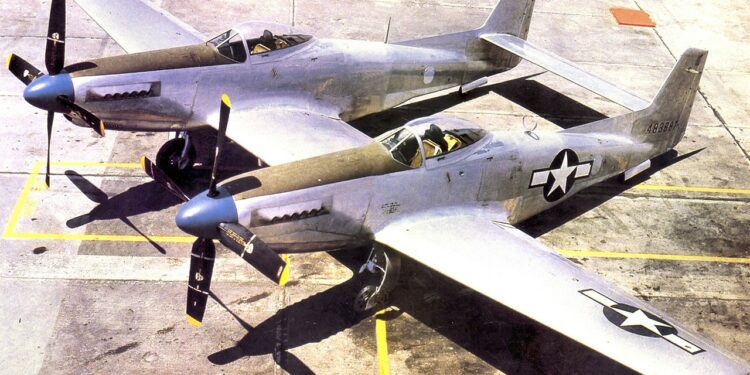Production Variants
With World War Two ending, the P-82s never made it to combat, at least not in that war. Two of the 20 initial P-82B models were converted to night fighters; one designated the P-82C, carrying the SCR-720 radar in a nacelle under the center wing, the other the P-82D which carried the smaller APS-4 radar. The right-hand cockpit became the radar operator’s home on the night fighter versions. P-82s were re-designated F-82s in June 1948.
The F-82E was the escort fighter version, with 100 of the type produced. Powered by two counter-rotating V-1710-143/145 liquid-cooled Allison engines, they entered service in early 1948, first assigned to Kearney Air Force Base in Nebraska. The escort version was designed to accompany heavy bombers such as the Boeing B-29 and B-50, as well as the giant Convair B-36 on long-range missions.
Production night fighter versions were designated the F-82F with the AN/APG28 radar, and the F-82G with the SCR72018 radar. These also incorporated autopilot features. They entered service in 1948 and became replacements for the Northrup P-61 Black Widow night-fighters for the Air Defense Command.
The F-82H was a winterized conversion of the F-82F/G models, with additional de-icing equipment installed and improved cockpit heating, along with updated radios. They served in Alaska as all-weather interceptors, escorted B-36 bombers, performed long-range reconnaissance patrols, and provided support Army ground operations while flying from Ladd Air Force Base and several isolated rough airstrips. They were even used to bomb and rocket ice jams in rivers to keep them flowing and prevent flooding. Retired in 1953, they were replaced by the Northrup F-89 Scorpion.
 One of the last operational F-82H models at Ladd Air Force Base, Alaska. Note the high visibility red placed on the outer wings and tail, this was done on aircraft operating in Arctic areas to assist with visual locating of downed aircraft in the snow and ice. (Image Credit:Â Wikimedia Commons)
One of the last operational F-82H models at Ladd Air Force Base, Alaska. Note the high visibility red placed on the outer wings and tail, this was done on aircraft operating in Arctic areas to assist with visual locating of downed aircraft in the snow and ice. (Image Credit:Â Wikimedia Commons)
Short Career with Big Accomplishments
Arriving at on the verge of the jet age, the F-82 had a short service life, but one of distinction. The F-82 could have been placed in storage and completely forgotten had it not been for the delays of jet-powered replacements coming into service. In 1947, it was discovered that the Soviet Union had reverse engineered America’s B-29 Superfortress heavy bomber and named it the Tupolev TU-4. Seen as an immediate threat to the United States mainland, the F-82 was pressed into all-weather interceptor use. Ironically, it would now not only serve to escort American B-29s, but now serve to intercept a Soviet copy of the aircraft as well. They would be on alert during the Berlin Airlift over the Pacific Northwest based from McChord Air Force Base in Washington and flew weather reconnaissance missions in that area in 1948.
Also in 1947, the P-82B tail number 44-65168 made aviation history by flying non-stop from Hickam Field, Hawaii, to LaGuardia Field, New York, in 14 hours 31 minutes and 50 seconds, a distance of 5,051 miles. The aircraft was stripped down and had extra fuel available in preparation for the longest non-stop flight ever made by a propeller driven aircraft.  Piloted by Lt. Col. Robert Thacker and Lt. John Ard, the aircraft, designated “Betty Jo” after Lt. Col. Thacker’s wife, is now on display after restoration at the National Museum of the United States Air Force in Dayton, Ohio.
 The record-setting F-82B “Betty Jo” on display at the National Museum of the United States Air Force in Dayton, Ohio. (Image Credit: United States Air Force)
The record-setting F-82B “Betty Jo” on display at the National Museum of the United States Air Force in Dayton, Ohio. (Image Credit: United States Air Force)
During a fierce blizzard in Jan. 1949, proving their all-weather abilities, F-82s took-off from Kearney Air Force base in Nebraska and rendezvoused with bombers of the Strategic Air Command to fly to Carswell Air Force Base in Fort Worth, Texas, for a celebration. All airports in the area of Kearney had been shut down due to the winter weather, but crews had cut paths for the F-82s in the snow allowing them to escape. Flyovers of President Truman’s inauguration as well as a dedication to New York City’s Idlewild Airport also included the F-82s from Kearney.
The type is credited with the destruction of 20 North Korean aircraft during the conflict while losing 11 Twin Mustangs in combat. On Jul. 10, 1950, F-82s along with B-26 and F-80 aircraft, attacked North Korean convoys, destroying 117 trucks and 38 armored vehicles and killing several enemy troops. The B-26s had destroyed a bridge preventing the escape of the road traffic, leading to one of the largest and most effective strikes on ground targets during the war. The F-82s range and firepower meant the enemy was not out of reach or safe in any of their occupied territory. In 1951-52 the F-82s were being replaced by the jet-powered F-94 Starfire in Korea, after the Twin Mustang had excelled in combat duties in the air, reconnaissance, and in ground attack roles. After service in Korea, several F-82s received cold weather modifications and were sent to Alaska as the F-82H. Cold temperatures and harsh weather, lack of parts, rugged field conditions, and wear and tear on already tired airframes led to the last of the Twin Mustangs being retired from Alaskan service in late 1953. Over 270 had been produced. Much like the war she fought in, the F-82 is often ignored, forgotten, or briefly mentioned as an afterthought in history books and media.
Separated Twins
In 1947, NACA (National Advisory Committee for Aeronautics), which was later known as NASA (National Aeronautics and Space Administration), received a North American XF-82 (XP-82) tail number 44-83887, the second prototype produced. The aircraft was used at the Flight Propulsion Laboratory in Cleveland, Ohio, to support tests of ramjet engines.
The ramjet missiles were mounted under the right wings of the aircraft, and test launched over the Atlantic beginning in 1948. Data was collected from the tests, conducted in this manner on the 16 ft long missiles as no wind tunnels existed capable of testing the ramjet engines.
On Dec. 19, 1948, the aircraft skidded off the runway after hitting ice patches. The ground in Cleveland had thawed because of warmer weather earlier in the week, and the aircraft hit mud and the wheels sunk deep into the earth. The left propeller, radiators, center wingspan, and wheel struts suffered damage, however no injuries occurred. NACA decided to scrap the aircraft instead of repairing it. It was towed away and the engines and propellers removed.
 The NACA XF-82 stuck in the mud after sliding off the runway in Cleveland, Ohio on December 14, 1949. The aircraft sustained damage and was sold, cut up and cannibalized, it sat for years. It was acquired in 2008 by Tom Reilly and restored to airworthy status. (Image Credit:Â NASA)
The NACA XF-82 stuck in the mud after sliding off the runway in Cleveland, Ohio on December 14, 1949. The aircraft sustained damage and was sold, cut up and cannibalized, it sat for years. It was acquired in 2008 by Tom Reilly and restored to airworthy status. (Image Credit:Â NASA)
A local collector of retired military aircraft named Walter Soplata purchased the aircraft, cutting it in half in order to transport it, and sold bits and pieces of the aircraft over the years. The right fuselage was re-acquired by the military and destroyed in testing.
In 1997, aircraft restorer Tom Reilly discovered the remains of the XF-82 at Soplata’s farm. Attempts to purchase it failed, however Reilly began searching for parts and investors to restore the aircraft. Finally, in 2008, Reilly was able to acquire the Twin Mustang and begin restoring it.
He and several other enthusiasts spent 207,000 hours restoring the aircraft. Parts from an Alaskan crash in 1950 were salvaged, an even the rare Rolls-Royce/Packard Merlin V-1650 engines were replaced. After over a decade of work, the aircraft was restored to flying condition and made its first flight on Jan. 28, 2019 in Georgia where the work had taken place. The aircraft flew publically that summer at Oshkosh, Wisconsin. Although originally designated an XP-82 when built, the aircraft is referred to as an XF-82 in the NACA logbooks. It is currently on display at the Warbird Museum in Titusville, Florida.
Source link : http://www.bing.com/news/apiclick.aspx?ref=FexRss&aid=&tid=67716eb906974a4b9a8b5191b56d8cf7&url=https%3A%2F%2Ftheaviationist.com%2F2024%2F12%2F29%2Fnorth-american-f-82-twin-mustang%2F&c=16802049914080830476&mkt=en-us
Author :
Publish date : 2024-12-29 00:52:00
Copyright for syndicated content belongs to the linked Source.












